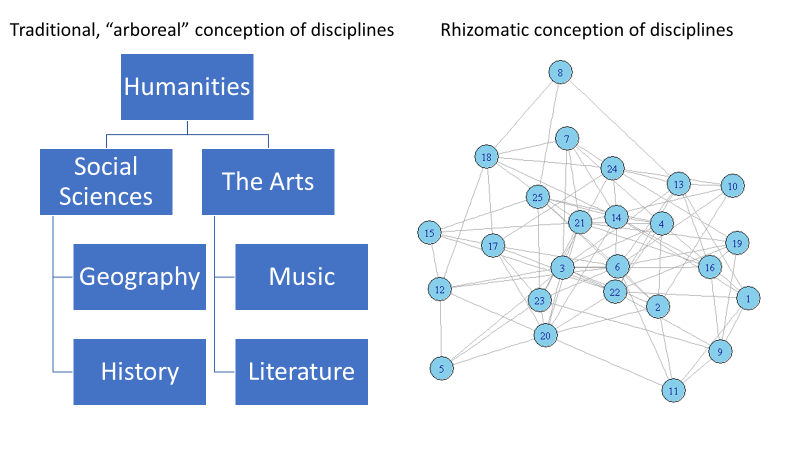In his “Two Cultures” lecture, C.P. Snow (1961) spoke of a “gulf of mutual incomprehension” between scientists and scholars of the humanities, resulting from their disparate perspectives on the world and what we can hope to know about it. Since the enlightenment, scientists have sought to unearth objective facts and present them in an unbiased manner, while scholars of the humanities have celebrated the role of human interpretation in building knowledge and understanding. In the succeeding decades, interdisciplinary or even transdisciplinary work has been called for, to solve increasingly complex problems, yet divides persist.
Interdisciplinary divides are not only in evidence between the sciences and humanities. They exist between quantitative and qualitative researchers, between practitioners and theorists, and between academic and business sectors (Kahn, 2011). Echoing the title of Deleuze and Guattari’s (1987) seminal book. “A Thousand Plateaus”, it is perhaps more accurate to speak of a thousand cultures than of two. Deleuze and Guattari used the analogy of rhizomes (modified plant stems which run underground horizontally) to describe aggregations of multiplicity as an alternative to “arboreal” conceptions of diverging roots or branches. We may consider “disciplines” in a similar way (see Figure 1). Within a rhizomatic conception of research, groups of researchers may share enough qualities that they may be considered to form a discipline, but each discipline will still be connected to the others.

Figure 1: Possible means of conceptualising disciplines. The image on the left is of a traditional, “arboreal” conception of disciplines, represented as a branching tree diagram. The image on the right is of an alternative, rhizomatic conception of disciplines, a horizontally interconnected network of researchers, represented here by numbered circles.
When we broaden our conception of cultures or disciplines, we acknowledge a wider range of types of interdisciplinary divide. Beyond the intellectual divides described by Snow (1961), structural divides emerge, including gulfs in the understanding and use of technology. There are institutional divides concerning conventions in career progression and journal publication, differences in academic calendars, and differences in working practices between academia and business (Kahn, 2011). Further, there is variation in conventions and language across different geographic locations.
How entity linkers can help us cross the divides
Different terms may be used in different disciplines to describe the same concept, or the same term may refer to different concepts depending on its disciplinary context. Both phenomena were encountered in a recent review of literature on the concept of “green prescriptions”. In New Zealand, the term, “green prescription” is used to describe the prescribing of physical activity as therapy (e.g. Anderson, 2015). In Europe, the term has been similarly adopted to describe the prescribing of activities carried out in natural settings as therapy (Van den Berg, 2017). This practice is also referred to in Europe as a performing “nature-based” (e.g. Barton, 2015) or “ecotherapy” (Bibby, 2013) interventions. In Germany, however, “green prescriptions” refer to a type of medical prescription, usually for complementary or supplementary medication (e.g. Heyde, 2014).
As the purpose of the literature review was to explore the prescribing of activities in natural environments, papers describing the New Zealand concept of a “green prescription” and papers describing the European concepts of green prescriptions and nature-based or ecotherapy interventions were relevant, while papers on the German “green prescription” were not. An entity linker would enhance a literature review of this kind, by expediting the uncovering of associated terms such as “nature-based intervention” while discarding unrelated papers, such as those using the term “green prescription” to describe the prescribing of supplementary medication.
Entity linkers have great potential aligning the different ways in which a term is discussed across disciplines, by removing ambiguity. Harnessing this capacity to search for references to the entity in question, discarding references to unrelated entities and including references which use different terminology, we may begin to bridge the divides between a thousand cultures or disciplines.
References
Anderson, Y. C., Taylor, G. M., Grant, C. C., Fulton, R. B. & Hofman, P. L. (2015) The green prescription active families programme in Taranaki, New Zealand 2007–2009: Did it reach children in need? Journal of Primary Health Care, 7(3), 192-197.
Barton, J., Sandercock, G., Pretty, J. & Wood, C. (2015) The effect of playground- and nature-based playtime interventions on physical activity and self-esteem in UK school children. International Journal of Environmental Health Research, 25(2), 196-206.
Bibby, P., Wild, A. & Bodell, S. (2013) The benefits of ecotherapy interventions on mental health conditions. British Journal of Occupational Therapy, 76, 47-47.
Deleuze, G. & Guatarri, F. (1987) A Thousand Plateus: Capitalism and Schizophrenia. (2ndEdn) University of Minnesota Press
Heyde, I., Böschen, D., Dicheva, S., Hinrichs, A. & Peters, H. (2014) Folic acid on green prescription: When adjunctive therapy is reimbursed. Deutsche Apotheker Zeitung, 154(19), 36-38.
Kahn, J. (2011) The two (institutional) cultures: a consideration of structural barriers to interdisciplinarity. Perspect Biol Med.,54(3):399-408.
Snow, C.P. (1961) The Two Cultures and The Scientific Revolution. New York: Cambridge University Press
Van den Berg, A. E. (2017) From green space to green prescriptions: Challenges and opportunities for research and practice.Frontiers in Psychology, 8.



One Reply to “A thousand cultures: bridging interdisciplinary divides”